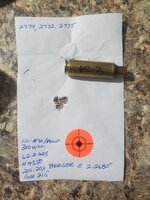I'll start by saying I'm aware of the Sherman SAUM based cartridge brass/reamer spec discrepancy, but I'm already waist deep so I'd rather discuss topics that will apply to reloading in general. Recently received my custom rifle chambered in 7 Sherman Max and fired 47 pcs of the fully formed ADG brass at a low charge recommended by Rich Sherman to "harden the case head" and finish form. Upon taking some measurements with calipers I was getting an expected .002" shoulder growth, but at roughly .200" above the case head I was getting consistent .006" web expansion. Unfired cases measure .545", all fired cases were .551" +/- .0005". I realize this was done rogue and with an improper tool, but my concern lies within the fact that it's consistent, and measurable. After chatting with the gunsmith and Rich, they said that growth is normal and the chamber/reamer measurement at .200" is .553". Too tight of a chamber causes clickers in the 7 SAUM based cartridges.
Both of these topics have extremely conflicting views. There are some gunsmiths that say .0005" web expansion is an indication of excessive pressure and you should stop immediately. Some claim any web expansion is a direct link to loose primer pockets, other say it depends on the headspace or shoulder growth. Rich and many others claim that firing at a low charge first firing will finish form and harden the case head and primer pocket, and from there you can do load development to find pressure and should get multiple firings.
Just looking to get some feedback instead of reading conflicting theory.
Both of these topics have extremely conflicting views. There are some gunsmiths that say .0005" web expansion is an indication of excessive pressure and you should stop immediately. Some claim any web expansion is a direct link to loose primer pockets, other say it depends on the headspace or shoulder growth. Rich and many others claim that firing at a low charge first firing will finish form and harden the case head and primer pocket, and from there you can do load development to find pressure and should get multiple firings.
Just looking to get some feedback instead of reading conflicting theory.

